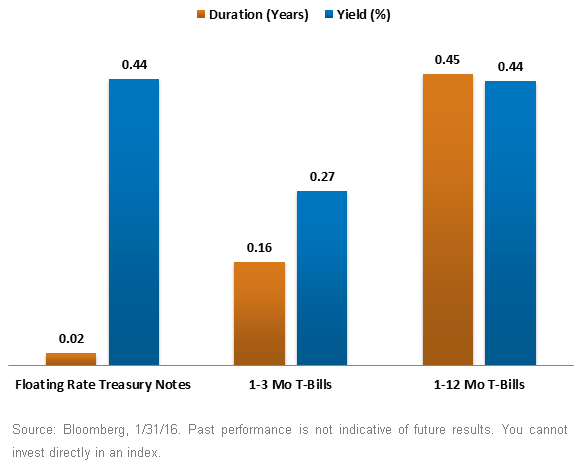As the Fed Continues to Hike, What’s Your Best Bet for Short Term Fixed Income?


 In the above chart:
Floating Rate Treasury Notes are represented by the Bloomberg U.S. Treasury Floating Rate Bond Index. 1-3 Month Treasury Bills are represented by the Barclays U.S. Treasury Bills Index: 1-3 Months. 1-12 Month Treasury Bills are represented by the Barclays Short Treasury Index.
Even though the credit quality may be similar in these strategies, the maturity and duration can be quite different. The duration on USFRNs is one week, or 0.019, considerably lower than that of one- to three-month T-bills and one- to 12-month T-bills, as shown above. The yield and duration characteristics alone make USFRNs a better investment over other short-term fixed income alternatives from a risk/reward standpoint.
Many investors employ a common strategy of rolling their Treasury Bill holdings every quarter. Investing in USFRNs, enables the investor to avoid the cost of eight purchases of T-bills over a two-year period. Not only does the investor reduce transaction costs, but USFRNs typically offer a spread over three-month Treasury Bills as compensation for holding the investment longer.
Over the past 30 years, the average spread of the Federal Funds Rate over three-month Treasury Bills has been about 0.24%. Over the past two years, however, it has been roughly 0.08%. Currently, the Fed governors’ median projection of the Fed Funds Rate is 1.375% by year-end. The market is a lot less confident that the Fed will raise rates that aggressively and is estimating the rate at 0.55% by December.3 Using the Fed’s projections, and the historical spread between the two rates, USFRNs could yield anywhere between 1.135% and 1.295% by year-end. Using the market’s estimation, it could be anywhere from 0.30% to 0.46%.
Compared to one- to three-month and one- to 12-month Treasury Bills, U.S. floating rate notes have similar credit quality, lower interest rate risk and the same to higher yield. Since the Fed is more likely to increase interest rates than to decrease them, investors should consider using U.S. floating rate notes as part of their short-term bond or cash allocations.
1Source: Bloomberg, 1/31/16.
2Source: Bloomberg, 1/31/16.
3Sources: Fed Funds December 2016 Futures contract, Bloomberg, 1/31/16.
In the above chart:
Floating Rate Treasury Notes are represented by the Bloomberg U.S. Treasury Floating Rate Bond Index. 1-3 Month Treasury Bills are represented by the Barclays U.S. Treasury Bills Index: 1-3 Months. 1-12 Month Treasury Bills are represented by the Barclays Short Treasury Index.
Even though the credit quality may be similar in these strategies, the maturity and duration can be quite different. The duration on USFRNs is one week, or 0.019, considerably lower than that of one- to three-month T-bills and one- to 12-month T-bills, as shown above. The yield and duration characteristics alone make USFRNs a better investment over other short-term fixed income alternatives from a risk/reward standpoint.
Many investors employ a common strategy of rolling their Treasury Bill holdings every quarter. Investing in USFRNs, enables the investor to avoid the cost of eight purchases of T-bills over a two-year period. Not only does the investor reduce transaction costs, but USFRNs typically offer a spread over three-month Treasury Bills as compensation for holding the investment longer.
Over the past 30 years, the average spread of the Federal Funds Rate over three-month Treasury Bills has been about 0.24%. Over the past two years, however, it has been roughly 0.08%. Currently, the Fed governors’ median projection of the Fed Funds Rate is 1.375% by year-end. The market is a lot less confident that the Fed will raise rates that aggressively and is estimating the rate at 0.55% by December.3 Using the Fed’s projections, and the historical spread between the two rates, USFRNs could yield anywhere between 1.135% and 1.295% by year-end. Using the market’s estimation, it could be anywhere from 0.30% to 0.46%.
Compared to one- to three-month and one- to 12-month Treasury Bills, U.S. floating rate notes have similar credit quality, lower interest rate risk and the same to higher yield. Since the Fed is more likely to increase interest rates than to decrease them, investors should consider using U.S. floating rate notes as part of their short-term bond or cash allocations.
1Source: Bloomberg, 1/31/16.
2Source: Bloomberg, 1/31/16.
3Sources: Fed Funds December 2016 Futures contract, Bloomberg, 1/31/16.
Important Risks Related to this Article
Fixed income investments are subject to interest rate risk; their value will normally decline as interest rates rise. In addition, when interest rates fall, income may decline. Fixed income investments are also subject to credit risk, the risk that the issuer of a bond will fail to pay interest and principal in a timely manner or that negative perceptions of the issuer’s ability to make such payments will cause the price of that bond to decline.


